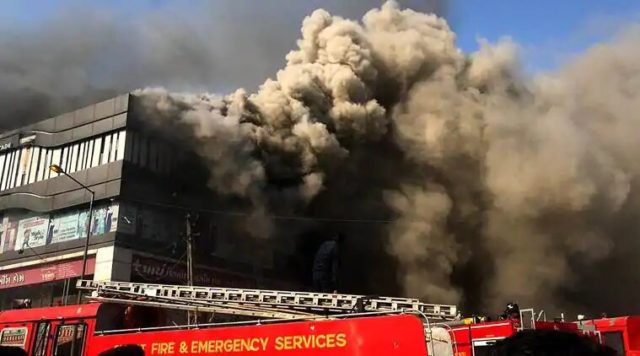
A massive fire broke out in Takshashila Complex in Sarthana of Surat district in Gujarat on Friday, 24 May 2019. The accident cost 22 students of a coaching institute being conducted on the roof of the complex, with their lives. The video of the incident with students jumping out of the window from the building in an attempt to save their lives has been in discussion in the country over the weekend.
Reportedly, the fire was a result of a short circuit. It spread heavily because of the presence of highly inflammable materials such as tyres instead of seats and tin roof. Absence of any fire safety equipment and fire exit caused many students to panic and lose their lives.
The Gujarat government has ordered an investigation into the incident. Two fire officers have been suspended for granting a safety clearance to the building. The police have arrested the Bhargav Bhutani, who ran the coaching centre, and have also registered a case against owners of the building – Harshal Vekaria and Jignesh Padgal.
After such fire incidents, the government insists on investigation, which always highlights issues such as non-compliant construction; lack of precautionary maintenance like the upkeep of extinguishers, fire doors, fire exits and their markings and assembly areas; gross overlook of safety procedures such as evacuation drills; and lack of recording of significant consideration for better response towards flammable materials, and their use in cladding and partitions walls. City-wide physical changes like the densification of areas, non-compliant use of properties, and change in their use — which leads to local traffic congestion or on-street parking that constricts fire tender movement or delays their access to the affected area — are also blamed. The pattern that the action is taken only after facing a disaster highlights the indifferent attitude among us.
The laws for governing fire safety are clearly defined in the National Building Code of India, 2016. Part 4 of the code is titled ‘Fire and Life Safety’ which covers the requirements for fire prevention, life safety in relation to fire and fire protection of buildings. The code specifies occupancy-wise classification, constructional aspects, egress requirements and protection features that are necessary to minimise danger to life and property from fire. It specifies the demarcations of fire zones, restrictions on constructions of buildings in each fire zone, classifications of buildings based on occupancy, types of building construction according to fire resistance of the structural and non-structural components and other restrictions and requirements necessary to minimise danger of life from fire,
smoke, fumes or panic before the buildings can be evacuated. Despite the well-defined code, the attitude of the engineers, builders, people as well as the inspectors is so indifferent that fire safety is often neglected in the building.
The attitude needs to change immediately. Apart from this, citizens should be educated on what to do if they are stuck in a fire incident. With Corporates and SMEs being more vigil about the fire standards of their office buildings and corporates doing their bit to impart education on fire safety through CSR, this is easily achievable.
Article Credit: CSR Journal
